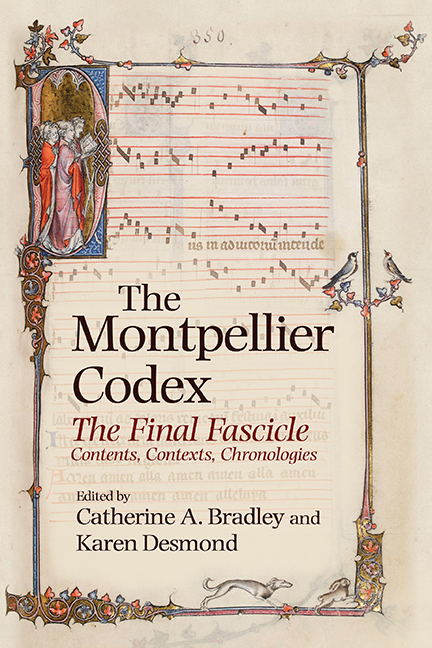Book contents
- Frontmatter
- Contents
- Figures
- Musical examples
- Tables
- Acknowledgements
- List of manuscript sigla
- Abbreviations
- Table of fascicle 8 contents
- Introduction
- I The Material Object
- 1 Montpellier 8: Anatomy of …
- 2 A Palaeographical Analysis of the Verbal Text in Montpellier 8: Problems, Implications, Opportunities
- 3 The Style and Iconography of Montpellier folio 35or
- 4 The Decoration of Montpellier 8: Its Place in the Continuum of Parisian Manuscript Illumination
- 5 Double Motet Layouts in the Montpellier Codex and Contemporaneous Libri motetorum
- 6 Deus in adiutorium Revisited: Sources and Contexts
- 7 Thematic Clusters and Compilational Strategies in Montpellier 8
- II INNOVATION AND TRADITION
- III ANALYTICAL CASE STUDIES
- Bibliography
- Contributors
- General index
- Index of compositions, alphabetical
- Index of compositions in Mo, manuscript order
- Miscellaneous Endmatter
7 - Thematic Clusters and Compilational Strategies in Montpellier 8
from I - The Material Object
Published online by Cambridge University Press: 04 July 2019
- Frontmatter
- Contents
- Figures
- Musical examples
- Tables
- Acknowledgements
- List of manuscript sigla
- Abbreviations
- Table of fascicle 8 contents
- Introduction
- I The Material Object
- 1 Montpellier 8: Anatomy of …
- 2 A Palaeographical Analysis of the Verbal Text in Montpellier 8: Problems, Implications, Opportunities
- 3 The Style and Iconography of Montpellier folio 35or
- 4 The Decoration of Montpellier 8: Its Place in the Continuum of Parisian Manuscript Illumination
- 5 Double Motet Layouts in the Montpellier Codex and Contemporaneous Libri motetorum
- 6 Deus in adiutorium Revisited: Sources and Contexts
- 7 Thematic Clusters and Compilational Strategies in Montpellier 8
- II INNOVATION AND TRADITION
- III ANALYTICAL CASE STUDIES
- Bibliography
- Contributors
- General index
- Index of compositions, alphabetical
- Index of compositions in Mo, manuscript order
- Miscellaneous Endmatter
Summary
As the largest surviving manuscript of medieval motets, Mo has attracted lively scholarly discussion, including intense studies of dating, codicology, and large-scale organization. Among the least controversial elements of the manuscript's structure is the generic organization of the so-called old corpus motets of Mo, found in fascicles 2–6. The motets in these sections seem to have been copied around the same time, and are arranged based on the number of voices and language: fascicles are devoted to triple motets, bilingual double motets, Latin double motets, French double motets, and French monotextual motets. This generic scheme is conspicuously lacking in the seventh and eighth fascicles: while the motets in these later sections are primarily French double motets, a number of Latin and bilingual motets appear among them. Furthermore, no fascicle of the codex easily yields evidence of internal organization – unlike in many contemporary motet collections and chansonniers, there is no generic, alphabetical, authorial, or liturgical pattern within each fascicle.
Mo also does not bear out any of the other, less obvious schemes recently uncovered in other seemingly unordered manuscripts. These alternate principles are often obscured by the interaction of multiple schemes. Catherine A. Bradley argues that the ordering of the second motet fascicle of F may relate to the presence of related clausulae and motets in F and other sources, or to the popularity of the motets. Katarzyna Grochowska's study of the Stary Saçz manuscript suggests that modal organization in the manner of a tonary could be applied to polyphonic works alongside liturgical ordering. But no such scheme applies to the organization of the large repertory of motets in Mo. Perhaps because the generic organization by fascicle is so clear, there has been little consideration of the precise selection and ordering of the motets within the larger fascicle groupings of the older corpus. The only organizational plans that have, to my knowledge, been suggested, are those of ‘relative popularity’ or chronological summa of the genre; such organization has been suggested by Edward Roesner and Emma Dillon respectively. Even these loose schemes have not been proposed in relation to the final two fascicles; explanations for the ordering of the eighth fascicle in particular can rely little on the metric of relative popularity, as nearly all of the motets are unica.
- Type
- Chapter
- Information
- The Montpellier CodexThe Final Fascicle. Contents, Contexts, Chronologies, pp. 121 - 136Publisher: Boydell & BrewerPrint publication year: 2018



